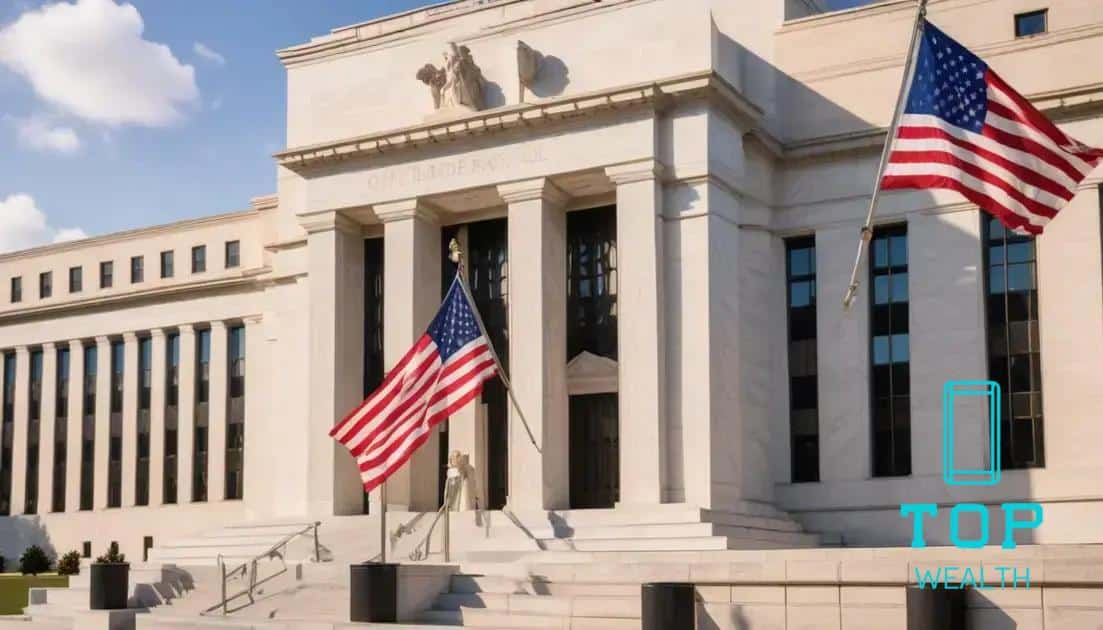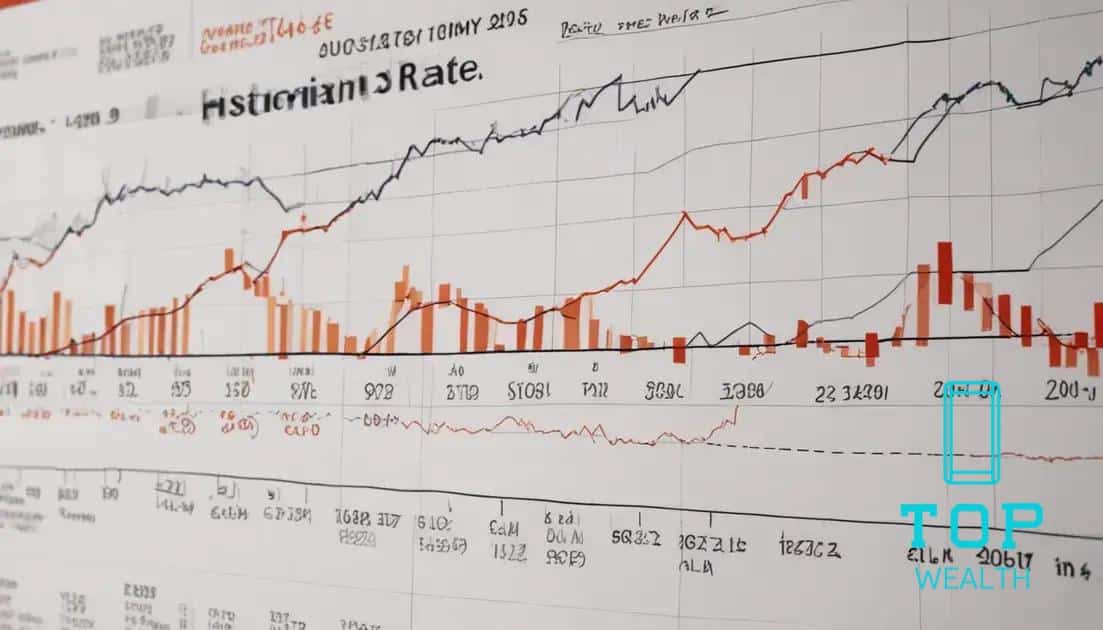Federal Reserve’s potential interest rate adjustments and their impact

The Federal Reserve’s interest rate adjustments directly impact economic health, influencing borrowing costs for consumers and businesses, as well as overall spending and investment in the economy.
Federal Reserve’s potential interest rate adjustments are a hot topic among economists and investors alike. How might these changes influence your financial decisions? Let’s dive into the intricacies of this important issue.
Understanding the Federal Reserve’s role in the economy
Understanding the Federal Reserve is crucial for grasping how our economy functions. The Fed plays a key role in managing the nation’s money supply and interest rates, influencing everything from inflation to employment.
What is the Federal Reserve?
The Federal Reserve, often called the Fed, is the central bank of the United States. Established in 1913, its main purpose is to provide the country with a safe, flexible, and stable monetary and financial system. The Fed has several important duties that shape economic policy.
Key Functions of the Federal Reserve
- Monetary Policy: The Fed controls the money supply and interest rates to influence economic activity.
- Financial Supervision: It supervises and regulates banks to ensure stability in the financial system.
- Financial Services: The Fed provides services to depository institutions, the government, and foreign institutions.
- Stability Goals: It aims to maintain low inflation and maximum employment.
Each function is intertwined with the others, creating a complex web that can impact the economy directly. For instance, when the Fed raises interest rates, it becomes more expensive to borrow money, which can slow down spending and investment.
In times of economic crisis, such as during a recession, the Federal Reserve can lower interest rates to encourage borrowing and spending. This helps stimulate economic growth, illustrating how its decisions can resonate throughout the economy. Understanding these mechanisms is critical for anyone looking to navigate financial markets or personal finances.
In addition, the Federal Reserve also plays a role in ensuring the stability of the banking system. By being a lender of last resort, it can provide loans to banks in trouble. This action helps prevent bank runs and maintains public confidence in the financial system.
Historical trends in interest rate adjustments

Exploring the historical trends in interest rate adjustments reveals valuable insights into the economic landscape. Understanding these trends helps us grasp how the Federal Reserve has navigated various economic challenges over the years.
The Evolution of Interest Rates
Interest rates in the United States have experienced significant fluctuations throughout history. Initially, rates were influenced largely by local and regional conditions. But as the economy grew, the Federal Reserve began to implement systematic adjustments based on broader economic indicators.
Major Periods of Change
- The Great Depression: During the 1930s, interest rates were lowered drastically to stimulate spending and investment.
- The 1970s Stagflation: A combination of high inflation and unemployment led the Fed to raise rates sharply to combat inflation.
- The 2008 Financial Crisis: In response to the recession, rates were slashed to near zero to boost the economy.
- The COVID-19 Pandemic: In 2020, the Fed again lowered rates to support economic recovery after widespread lockdowns.
These adjustments reflect the Fed’s efforts to manage economic growth and stability. For instance, lowering rates often encourages borrowing, which can spur consumer spending and investment. Conversely, raising rates is typically used to combat inflation when the economy is overheated.
A close look at past adjustments shows a pattern of responsive measures. After the 2008 financial crisis, the Fed maintained low rates for an extended period to foster recovery. Then, as the economy improved, a gradual increase in rates began to occur to prevent overheating. Each decision was based on a careful analysis of various economic factors.
Overall, the historical trends in interest rate adjustments highlight the delicate balance the Fed must maintain between stimulating growth and controlling inflation. These trends not only shape monetary policy but also influence financial markets and consumer decisions throughout the economy.
Factors influencing the Federal Reserve’s decisions
Understanding the factors influencing the Federal Reserve’s decisions is important for grasping its role in shaping the economy. The Fed considers various elements that affect its monetary policy and interest rate adjustments.
Economic Indicators
The Federal Reserve closely monitors economic indicators such as inflation, unemployment rates, and GDP growth. These metrics provide insights into the current state of the economy and help guide decision-making. For instance, a rise in inflation may prompt the Fed to increase interest rates to control price levels.
Global Economic Conditions
Global events also impact the Fed’s decisions. Changes in foreign economies, trade relations, and geopolitical tensions can influence monetary policy, as the Fed strives to maintain stability at home. A slowdown in major economies can lead to cautious policymaking.
- Inflation Trends: If inflation rises significantly, the Fed is likely to react.
- Unemployment Rates: Low unemployment can indicate a strong economy but can also create inflationary pressures.
- Consumer Spending: An increase in consumer spending can influence the Fed to adjust rates.
- Market Stability: Financial market conditions may prompt preemptive actions to avoid instability.
Additionally, public expectations and confidence in the economy play crucial roles in the Fed’s decision-making process. If consumers and businesses expect inflation, they may adjust spending habits, further influencing economic conditions. The Fed pays attention to these expectations to mitigate potential negative outcomes.
Political considerations can also play a part. While the Fed operates independently, pressures from the government or public opinion can influence its policies. It’s critical for the Fed to communicate effectively and maintain credibility to ensure the stability of financial markets.
The nuances of the factors influencing the Federal Reserve’s decisions illustrate the complex nature of monetary policy. By analyzing various indicators and considering global influences, the Fed aims to make informed decisions that promote economic growth and stability.
Impacts of interest rate changes on consumers and businesses

The impacts of interest rate changes on consumers and businesses are significant, affecting everything from borrowing costs to spending behaviors. Adjustments in interest rates can have immediate effects on the economy.
Effects on Consumers
When the Federal Reserve raises interest rates, consumer loans, like mortgages and auto loans, become more expensive. Higher rates can lead to increased monthly payments for borrowers. As a result, many consumers may choose to postpone significant purchases, like buying a house or a car.
Consumers’ Spending Habits
With higher interest rates, consumers might cut back on non-essential spending. This reduction can impact businesses reliant on consumer purchases. As spending decreases, businesses may experience lower sales, leading to reduced profits.
- Credit Cards: Higher interest rates mean carrying a balance on credit cards becomes costlier.
- Housing Market: Increased mortgage rates can slow down home sales, affecting real estate values.
- Auto Loans: Higher costs can deter consumers from financing new cars.
- Personal Loans: More costly loans can prevent consumers from accessing needed funds for expenses.
As for businesses, increased borrowing costs may cause them to rethink their investment plans. Companies often rely on loans to expand operations or invest in new technology. When interest rates rise, they may choose to delay these projects due to higher financing costs.
Businesses focused on growth must adapt to changing economic conditions. Higher rates can lead to reduced cash flow, forcing businesses to reconsider their budgets and spending strategies. This environment can stifle expansion and innovation.
The impacts of interest rate changes are far-reaching. Businesses may need to evaluate their pricing strategies based on changes in consumer spending. If consumers are cutting back, businesses might need to offer promotions or discounts to entice purchases.
Future outlook for interest rates and economic health
The future outlook for interest rates and economic health is a topic of great interest among economists, investors, and consumers. As the Federal Reserve adjusts its policies, understanding the potential direction of interest rates can help everyone make informed decisions.
Projected Interest Rate Trends
Analysts forecast that interest rates may continue to fluctuate based on economic conditions. If inflation stabilizes and the economy shows signs of steady growth, the Fed might consider gradual increases in interest rates. Conversely, if economic challenges arise, a more cautious approach could lead to lower rates.
Key Economic Indicators
- Inflation Rates: Persistent inflation could force the Fed to act more aggressively.
- Employment Levels: If job growth continues, higher rates may be implemented to prevent overheating.
- Consumer Confidence: Rising confidence can lead to increased spending, influencing rate decisions.
- Global Economic Factors: International events can impact domestic policies and projections.
The overall health of the economy plays a crucial role in determining the future of interest rates. A robust economy often leads to higher interest rates to counter inflation. On the other hand, economic downturns usually prompt the Fed to lower rates to stimulate growth.
As consumers and businesses adjust to these conditions, understanding the future outlook for interest rates becomes vital. For businesses, anticipating rate changes can help in planning investments and financing options. For consumers, it can impact loan decisions and spending habits.
Ultimately, the dynamic interplay between economic indicators and interest rates will shape the financial landscape. Keeping an eye on these trends can provide valuable insights into making strategic financial choices.
In conclusion, understanding the dynamics of interest rates and their impact on the economy is vital for both consumers and businesses. The Federal Reserve plays a crucial role in adjusting interest rates, responding to various economic indicators. As we look ahead, it is important to keep an eye on factors like inflation, employment, and global conditions, as they will shape the future of interest rates and economic health. By staying informed, individuals and businesses can make smarter financial decisions to navigate the changing landscape.
FAQ – Frequently Asked Questions about Interest Rates and Economic Health
How do interest rate changes affect consumers?
Interest rate changes directly affect borrowing costs, influencing decisions on loans, mortgages, and credit cards.
What factors does the Federal Reserve consider when adjusting rates?
The Fed considers economic indicators like inflation, employment rates, and global economic conditions to guide its rate adjustments.
How can businesses prepare for interest rate changes?
Businesses can review their financing strategies and adjust budgets to accommodate potential changes in borrowing costs due to rate adjustments.
Why is it important to stay informed about interest rates?
Staying informed about interest rates helps consumers and businesses make better financial decisions and plan for future expenses.





